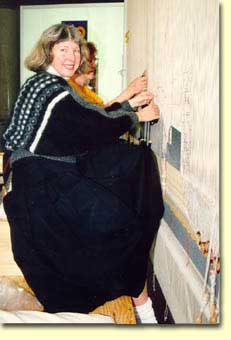
Political Awareness | In Parliament | The Workplace | Why South Australia?
The Aboriginal Voice | Cultural Diversity

 Weaving
our way into history
Weaving
our way into history
Story by Rosemary Cadden
Thousands of South Australian women took the opportunity to "make a pass into history" by weaving a few stitches in the commemorative tapestries to celebrate the Centenary of Women's Suffrage in South Australia, including Women & Politics Webmistress Carolyn Spooner. One hundred years after South Australian women won the right to stand for election to State Parliament, space was finally dedicated on the walls of the House of Assembly in North Terrace, Adelaide, to commemorate South Australia's great constitutional achievement. Two tapestries, one depicting 19th century and the other depicting 20th century events and issues, were ceremoniously hung on 19 October 1994, in the centre of the Chamber, a powerful gesture to acknowledge the achievements of women over the past Century. With the faces of pioneer suffragists Mary Lee, Catherine Helen Spence and Elizabeth Webb Nicholls on one tapestry, female faces at last share a position with the all-male portraits on the wall.
The concept for the tapestries, one of the major projects on the extensive Calendar of Events to mark SA's Centenary of Women's Suffrage, stemmed from the desire to establish lasting commemorations of the Year long after 1994 came to a close.
"There is nothing whatsoever in this Parliament that indicates our unique distinction of being the first democracy in the world to give women the right to stand for Parliament," Jennifer Cashmore, then a Member of Parliament, told the House of Assembly on February 1993. "I am sure all members will acknowledge that deficiency should be remedied and that the time to remedy it is 1994, the centenary of women's suffrage. "It should be evident in this Chamber as a perpetual reminder to members, staff and visitors that this State was settled by men and women and that the achievements and influence of women have to often been disregarded. "I look for the day when there are equal numbers of men and women in this Chamber and in the meantime I look forward with happy anticipation to the hanging of the tapestries with the consent and approval of the House."
The tapestries were designed by Kay Lawrence AM, who, a decade earlier, was responsible for designing the embroidery in the Great Hall in Parliament House, Canberra. The images on the tapestries:
recognise the importance of historic constitutional achievements;
inform and educate the community about the obstacles which have been overcome and the legacy handed on to today's generation;
foster understanding of women's participation in the development of South Australia; and
celebrate all aspects of women's lives.
Sixteen volunteer community weavers, coordinated by Elaine Gardner, spent about 5000 hours on public view in the foyer of the National Bank at 22 King William Street, Adelaide, as the tapestries took shape and passers-by, invited to make a contribution, recorded their names to the list of participants. More than 1000 South Australians enthusiastically took the opportunity to weave their way into history and take part in the community project.
Busloads of women came from country towns to pick up the shuttle and "make a pass", South Australian politicians made special visits to make their mark and visiting dignitaries including international feminist authors, Deirdre Bair, Sarah Peretsky and Marilyn French, made a point of adding their touch to the emerging pictures when they were visiting the city.
The tradition of using woven tapestry as a medium to commemorate significant occasions is well documented over the centuries, Jennifer Cashmore said. And the concept of a community tapestry woven in public view and with public participation was particularly important.
The first tapestry was officially launched on 16 August 16 1993 by Ms Betty Churcher, Director of the Australian National Gallery who said they would be recognised as major works of international significance, both artistically and historically.
The 19th Century tapestry celebrates the women suffragists who worked with concerned men, including Members of Parliament , for the passage of the Constitution Amendment Act of 1894. It depicts symbols, including a wedding veil, and a will expressing the intent of the Married Women's Property Act of 1884 which, for the first time, gave a married woman the right to own property in her own name.
On 20 April 1994, the Governor of South Australia, Her Excellency Dame Roma Mitchell, launched the second tapestry. A silhouette of a judge on the tapestry represents Dame Roma, the first woman Supreme Court judge and the first woman State Governor in Australia. The tapestry launch was 30 years after Dame Roma, as Miss Roma Mitchell QC, led a deputation to Premier Tom Playford urging the government to grant women the right to serve on juries, and this is commemorated in one of the symbols on the tapestry outlining a number of campaigns which led to pioneering efforts and justice for women this Century.
The 20th Century tapestry depicts the Guardianship of Infants Act 1940 which, for the first time in Australia, gave mothers the same rights as fathers in the guardianship of their children. The tapestry also expresses the intent of the Sex Discrimination Act 1975 and the subsequent Equal Opportunities Act 1984, which prohibit discrimination against women in relation to employment, education and other matters.

| Copyright
©
2001 State Library of South Australia Disclaimer This page last updated on Thursday 24 October, 2013 14:18 Comments and enquiries to webmaster@slsa.sa.gov.au |
State Library of South Australia
North Terrace Adelaide 5000 Phone : +61 8 8207 7250 Fax : +61 8 8207 7307 Freecall : 1800 182 013 |